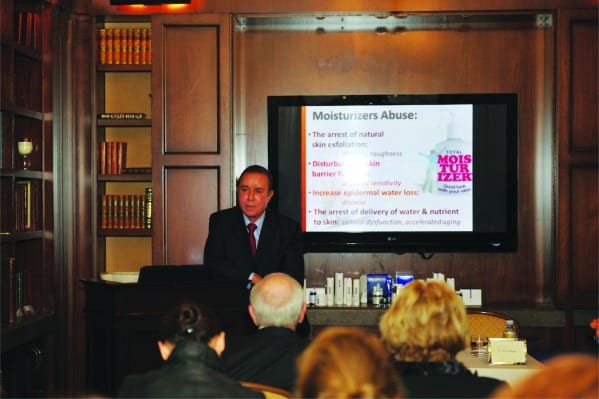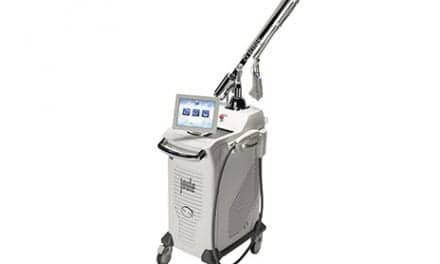By Wendy Lewis
The 24th Ultimate Skin Health Symposium (www.ultimateskinsynposium.com) was held at the Montage Hotel in Beverly Hills, Calif, on November 9-11, 2012. The program was specifically designed to present new principles and novel ideas to encourage creativity among physicians and skincare professionals in how they treat each patient.
According to course chairman Zein Obagi, MD, “As dermatologists and plastic surgeons, we are focusing more on procedures without addressing skin in an effective way. At this symposium, our aim was to address the skin and what it needs, and identify the best procedure to be performed based on skin type. My goal is to try to unify the approach to treatments for rejuvenation by addressing the skin as the main essential step. That is why we chose the name the Ultimate Skin Health Symposium. We are trying to convey to physicians, nurses, and medical aestheticians that our main focus is skin.”
 |
| Zein Obagi, MD, talks about moisturizer abuse at the media breakfast. |
Attendees were immersed in 2 full days of in-depth treatment protocols for a wide range of skin conditions, including photodamage, pigmentation and melasma, rosacea, acne, scars, and wrinkles. In addition to the 2-day CME program, there was a non-CME portion of the conference held on Sunday, November 11. A-list exhibitors included Ellman International, Envy Medical, Ulthera, Valeant, Sciton, Dermasculpt, Cynosure, Canfield Imaging Systems, Cutera, EMAGE LLC, Genesis Biosystems Inc, JEC Medical Inc, Solta Medical, NuFACE, and ZO Skin Health Inc.
Obagi wowed the audience with his results from reversing severe hyperpigmentation on skin of color, and offered his new thinking about the potentially dangerous long-term side effects of hydroquinone usage without medical supervision. He stressed the importance of selecting the right topical agents and the most efficacious procedures. “The enemies of skin are sun exposure and sebum, both of which induce inflammation,” he says.
Featuring a faculty of dermatologists, plastic surgeons, and anti-aging physicians, the symposium ticked all the boxes for today’s aesthetic practitioners interested in learning about skin-rejuvenation concepts. “The Ultimate Skin Health Symposium was the most comprehensive event dedicated to the education of skin quality and excellence,” says Barry DiBernardo, MD, a plastic surgeon from Montclair, NJ.
 |
| Drs Kiripolsky, Obagi, Fitzgerald, and Bucay |
“Adjunctive treatments including lasers, devices, and hormonal management of aging were covered to illustrate the multi-modality approach to the ideal skin condition.” DiBernardo’s presentation featured an update on body-shaping devices for nonsurgical fat reduction, skin tightening, and cellulite. He shared some results from a wide range of energy-based systems that are currently available.
San Diego-based dermatologist Edward Victor Ross, MD, presented a lecture on the newest advancements in skin-resurfacing technologies. He advised attendees that every practice needs a solution for all aesthetic problems, including skin texture, loose skin, wrinkles, pigmented lesions, acne, hair, vascular lesions, cellulite, and fat. Ross focused on the five basic categories of systems in terms
of new technologies:
- Visible light to treat reds and browns;
- Resurfacing technology;
- Hair removal;
- Nonablative rejuvenation technology; and
- Skin tightening.
Conventional CO2 and erbium laser resurfacing still have a role to play in rejuvenation, Ross says.
 |
|
Monika Kiripolsky, MD, with Vivian W. Bucay, MD |
“Overall, however, nonablative fractional lasers are more commonly applied than their ablative counterparts. This trend is a result of the decreased downtime and decreased wound care associated with nonablative lasers,” he says. Nonablative lasers tend to achieve results almost equal to ablative fractional lasers for certain acne scar types, and nonablative fractional lasers are also useful for facial scars when the immediate postoperative appearance is very important. “We might see more combination techniques where nonablative and ablative fractional lasers are deployed in the same session,” Ross explains.
Los Angeles-based dermatologist Rebecca Fitzgerald, MD, gave a talk titled, “The Art and Science of Volume Replacement.” She spoke of the “multiple tissue issue” in that the time, amount, and effort of any cosmetic procedure to achieve an optimal result is contingent on the quality of the patient’s tissue. Therefore, she says, a youthful face represents a point in time when a particular set of skeletal proportions is ideal for their soft-tissue envelope. She stressed that it is important to evaluate the integrity of ALL structural tissues. “Replacing a little volume as one starts to lose it is easier and more cost-effective than delaying initiation of treatments.”
Fitzgerald also joined Obagi in the live patient event, where she demonstrated her techniques for patient assessment and shared some of her injection pearls with the attendees.
Z. Paul Lorenc, MD, a plastic surgeon from New York, offered a comprehensive science-based evaluation of neuromodulators and dermal fillers, including those that are FDA cleared and those currently undergoing clinical investigation. His presentation focused on hyaluronic acid gels and the variations between commercially available products in terms of concentration, cross linking, and particle size. Lorenc also discussed collagen-stimulating effects of Sculptra Aesthetic®, Radiesse®, and ArteFill®, and stressed the trend of combination therapies. He also touched on increased interest in autologous fat grafting and platelet-rich-plasma (PRP), both combined and as stand-alone treatments. Lorenc and Fitzgerald both emphasized the importance of restoring the volume of the medial deep fat pad for enhanced results.
Patrick Trevidic, MD, a plastic surgeon from Paris, further advanced the growing trend of using new variations of cannulae and soft needles. Blunt tip cannulas are becoming increasingly popular for filler injections in Europe as well as the US. They can reduce the risk of perforating blood vessels and damaging nerves. Trevidic stressed that to ensure a successful injection and a reliable treatment, two major steps must be mastered: First, one needs to understand the anatomy of the treated region. Second, one must master the use of cannula, since a blunt tip leaves little room for error and can be used for a painless injection. According to Trevidic, doctors first filled wrinkles, but when technology became better, procedures became better, which allowed them to restore facial volumes. “We need to consider that successful aesthetic treatments also require a minimum of artistic talent in order to achieve an overall natural look,” he says. “Better knowledge of physiologic hyaluronic acid functions will offer us in the [near] future the possibility to discover and to propose refinements in anti-aging techniques.”
 |
| Dr and Mrs Jarl Bunaes with Dr and Mrs Obagi. |
Vivian W. Bucay, MD, a dermatologist in San Antonio, spoke on the “Combination Approach: Rejuvenating the Aging Face,” and conducted an informative workshop on the use of the Pellevé® Wrinkle Reduction System. An additional workshop presented by San Diego dermatologist Tess Mauricio, MD, demonstrated the HydraFacial™ system for skin resurfacing.
Bucay told the crowd that the goals of rejuvenation are restoration of healthy, youthful skin, meaning smooth texture, even tone, and luminous with a minimum of vascular and pigmented lesions; restoration of facial volume and contours while respecting the patient’s inherent facial structure and animation; and harmony with nonfacial areas such as the neck, chest, and hands. “In order to rejuvenate skin, we must tackle fine lines and wrinkles, hyperpigmentation, and vascular changes by refreshing the skin with topical skincare products, chemical peels, fractional nonablative or ablative resurfacing, and laser and/or IPL for photodamage,” she says. “Chemodenervation with Botox can be used to relax wrinkles, while fillers or biostimulators can replace age-related volume loss.” Another core message, Bucay adds, is that a comprehensive skincare regimen should incorporate the following: sunscreen, antioxidants, retinoids, collagen boosters, and DNA repair enzymes.
“Chemical peels are an excellent and powerful tool in the treatment of hyperpigmentation and photoaging,” Bucay says. “Although much attention is given to laser technology, lasers and IPL can backfire in treating pigmentation problems. Obagi stressed the need for ‘melanocyte stabilization’ in the treatment of dyschromias.” She adds that Obagi demonstrated that using the appropriate chemical peel to target what he refers to as the immediate reticular dermis can produce skin tightening.
Bucay also cited Fitzgerald’s comprehensive and elegant analysis of the anatomic changes that contribute to the aging face. “Dr Fitzgerald’s synthesis of various landmark publications, such as the ground-breaking work of Joel Pessa, MD, and Rod Rohrich, MD, at UT Southwestern in Dallas regarding the fat compartments in the face, has increased my understanding of the complexities of facial aging. I have become a better injector since first hearing Dr Fitzgerald’s presentations.”
| Watch the Video See an exclusive video interview with Dr Obagi speaking about his Skin Symposium and consumers’ misperceptions about the skin. |
In addition to hyperpigmentation and melasma, treating acne and hypertrophic scars were a focus of theprogram. Lorenc mentioned his experience with a novel patented handheld intralesional probe for treating keloid and hypertrophic scars by destroying deep tissue, called CryoShape.® Obagi put forth his method of treating keloid scars with aggressive stimulation and blending, steroid injections, flash lamp pumped dye laser, and silicone gel sheeting.
After the 2-day symposium wrapped, physicians possessed knowledge and the tools to take care of their patients properly. “We covered everything from how to recommend a daily skincare program, how to recommend a preventive approach, how to treat a medical condition quickly to restore healthy skin, and how to maintain the results indefinitely,” Obagi says. “Maintenance is very important, and it will help patients to stay with you. Think of your clinic like a skin health club. You really want those patients to become members in that club. Guide them, teach them, help them, and don’t let them waste their money on unnecessary treatments. That is very rewarding to our careers as practitioners.”
Wendy Lewis is President of Wendy Lewis and Co Ltd, Global Aesthetics Consultancy http://www.wendylewisco.com, author of 11 books, Founder/Editor in Chief of http://www.beautyinthebag.com, and contributing editor of PSP. [email protected].



